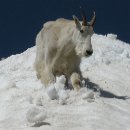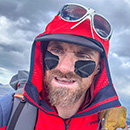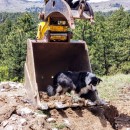Afternoon Ascents
Forum rules
- This is a mountaineering forum, so please keep your posts on-topic. Posts do not all have to be related to the 14ers but should at least be mountaineering-related.
- Personal attacks and confrontational behavior will result in removal from the forum at the discretion of the administrators.
- Do not use this forum to advertise, sell photos or other products or promote a commercial website.
- Posts will be removed at the discretion of the site administrator or moderator(s), including: Troll posts, posts pushing political views or religious beliefs, and posts with the purpose of instigating conflict within the forum.
-
MichiganMan
- Posts: 6
- Joined: 5/1/2017
- 14ers: 1
- Trip Reports (0)
Afternoon Ascents
Seems like I usually hear that it is best to hike at high elevations in the morning, as the threat of thunderstorms is worse in the afternoon. I guess I've heard that it's best to have summited and be heading down by noon. Yet I've read several threads where folks are hiking and summiting fourteeners in the afternoon or evening. What's the skinny? Thanks...
-
peter303
- Posts: 3570
- Joined: 6/17/2009
- 14ers: 34
- 13ers: 12
- Trip Reports (3)
Re: Afternoon Ascents
Lightning is a distant 3rd cause of death in mountain hiking after falls (60%) and exposure/hyperthermia (20%). But anyone who has been in a lightning storm knows how psychologically terrifying they can feel.
-
Scott P

- Posts: 9598
- Joined: 5/4/2005
- 14ers: 58 16
- 13ers: 50 13
- Trip Reports (16)
Re: Afternoon Ascents
Usually thunderstorms happen in the afternoon, but occasionally there are clear afternoons and thunderstorms in the morning.
Also, thunderstorms are mostly in summer. At the other times of the year they are less common.
Also, thunderstorms are mostly in summer. At the other times of the year they are less common.
I'm old, slow and fat. Unfortunately, those are my good qualities.
-
Monster5

- Posts: 1775
- Joined: 8/7/2009
- 14ers: 58 34
- 13ers: 291 37
- Trip Reports (28)
Re: Afternoon Ascents
Eh as you hike more and more peaks, you'll get a better feel for weather and weather windows. A lot of the time, we'll get a one boom wonder around noon followed by reasonable weather for several hours. It's best to stick to the AM starting out and in general. Personally, I love sqeezing in sunset summits. Makes for fantastic pictures.
"The road to alpine climbing is pocked and poorly marked, ending at an unexpectedly closed gate 5 miles from the trailhead." - MP user Beckerich
-
DArcyS

- Posts: 949
- Joined: 5/11/2007
- 14ers: 58
- 13ers: 552
- Trip Reports (3)
Re: Afternoon Ascents
Much of it depends upon the time of year. September can produce stable weather patterns where there's little risk for t-storms. If there's a 30-40% chance for t-storms in the summer, I don't sleep in and risk throwing a hiking day away by having a t-storm chase me off a peak. I'll frequently hit the trail in the summertime before 6 and summit before 10, and almost always this practice yields a successful summit. If you're serious about the summit, the best practice is to start early. Better to lose some sleep than your life. If you're in it to do some casual climbing and don't mind a failed summit attempt, there's nothing wrong with a late start if you have the discipline to turn back at the first hint of bad weather, which can develop far faster than you can descend in the worst case scenario where a severe thunderstorm develops directly above you in under an hour. Understand that in the worst cases, you don't see a developed storm slowly approach from a distance; rather, the storm develops rapidly overhead with little warning and you become a sitting duck.
-
TallGrass

- Posts: 2328
- Joined: 6/29/2012
- 13ers: 26
- Trip Reports (0)
Re: Afternoon Ascents
"Off the summit by noon" is for two reasons: afternoon "monsoon" storms are more common in summer (July-August), and to a lesser degree "half" your daylight is spent. Storms can roll in anytime of year, night hiking and navigation are doable, and there are plenty of good weather afternoons in July-August too. It's a good rule to start with, but like others have said, with experience and skills (reading clouds, forecast data) you can make more informed guesses.
My first try at a 14er (unsuccessful) saw me making the Notch Shelter (~13,000') just as night fell even though I started at dawn. Second attempt (successful), I left the TH around 4pm as I intended to hike through the night but ended up bivying a few hours on HCR (~13,800). I left the TH for my fourth 14er at 11am, summitted at like 6pm or something, and made my way out in the dark changing the batteries in my flashlight once (fun to do in the dark, eh?) in awesome night weather (calm, clear, warm). I've returned to camp or the TH under darkness multiple times.
I'd recommend carrying two light sources (e.g. two headlamps, or headlamp and flashlight) that use the same batteries (e.g. 3 x AAA), with one tucked away securely in your pack's brain along with a spare set of batteries. If you drop one in the dark when it's turned off, at least you have a back up.
My first try at a 14er (unsuccessful) saw me making the Notch Shelter (~13,000') just as night fell even though I started at dawn. Second attempt (successful), I left the TH around 4pm as I intended to hike through the night but ended up bivying a few hours on HCR (~13,800). I left the TH for my fourth 14er at 11am, summitted at like 6pm or something, and made my way out in the dark changing the batteries in my flashlight once (fun to do in the dark, eh?) in awesome night weather (calm, clear, warm). I've returned to camp or the TH under darkness multiple times.
I'd recommend carrying two light sources (e.g. two headlamps, or headlamp and flashlight) that use the same batteries (e.g. 3 x AAA), with one tucked away securely in your pack's brain along with a spare set of batteries. If you drop one in the dark when it's turned off, at least you have a back up.
"A few hours' mountain climbing make of a rogue and a saint two fairly equal creatures.
Tiredness is the shortest path to equality and fraternity - and sleep finally adds to them liberty."
Tiredness is the shortest path to equality and fraternity - and sleep finally adds to them liberty."
-
DArcyS

- Posts: 949
- Joined: 5/11/2007
- 14ers: 58
- 13ers: 552
- Trip Reports (3)
Re: Afternoon Ascents
An old thread discussing how innocent looking weather can turn south quickly. In my photos, note how there's no vertical build to the clouds and the cloud coverage is far from alarming. Yet, within an hour there was a bad storm above me.
https://www.14ers.com/forum/viewtopic.php?f=1&t=31538
I knew t-storms were in the forecast, but I was a little surprised at how quickly they developed. If you're going to do afternoon ascents, knowing the forecast is probably a good idea, as sometimes interpreting the weather in the field won't be enough.
https://www.14ers.com/forum/viewtopic.php?f=1&t=31538
I knew t-storms were in the forecast, but I was a little surprised at how quickly they developed. If you're going to do afternoon ascents, knowing the forecast is probably a good idea, as sometimes interpreting the weather in the field won't be enough.
-
JChitwood

- Posts: 641
- Joined: 8/29/2011
- 14ers: 58
- 13ers: 56
- Trip Reports (0)
Re: Afternoon Ascents
It's all in the day and the time of year. I have clambered onto more than half my summits after 2 PM and a fair amount of them after 3 because I like hiking in the middle of the day and I am not a morning person. BUT, I choose my days in the mountains very carefully and am prepared to turn back if I get to tree line and weather conditions are not near perfect. It has not happened many times because I don't even start if the forecast is not favorable. If there is a significant chance of storms and I am committed to hiking usually because that is the only day a partner can make it, I bite the bullet and start early, it will almost always give you the best chance of gaining the summit. We do have clear days even in mid summer but September and October are my favorite times to get out and storms generally don't build from nowhere that time of year.
"I'll make it." - Jimmy Chitwood
-
montanahiker

- Posts: 275
- Joined: 8/30/2015
- 14ers: 39
- 13ers: 216
- Trip Reports (0)
Re: Afternoon Ascents
I"ll second the afternoon storm talk. I can't count how many times it has started raining as I was starting my drive home and I couldn't believe how many people were just starting up the trail.
Also, as someone who does a lot of day trips from Denver, if you leave before sunrise you also don't have to worry about I-70 or I-25 traffic.
Also, as someone who does a lot of day trips from Denver, if you leave before sunrise you also don't have to worry about I-70 or I-25 traffic.
There's more to life than 14ers. There are 13ers.
-
justiner

- Posts: 4690
- Joined: 8/28/2010
- 14ers: 3 1
- Trip Reports (37)
Re: Afternoon Ascents
So late afternoon/evening ascents can be more dangerous: you need more gear to stay warm/see in the dark, there's the thunderboom problems, what happens if you get lost because of the dark/benighted, less of a safety margin of daylight, harder for others to spot you, giant hungry forest-dwelling animals that only come out at night - yadda yadda.
Watching sunsets from the summits are pretty sweet, but so are sunrises.
It's riskier, but afternoon ascents can be done, but it's nice to have a plan if things hit the fan - how fast can you descend? Are you comfortable going down a random ridgeline (then perhaps back up afterwards) to safety? Can you spot shelter (cave)? Can you now safely go down when things are all wet and slippery (and rockfall happens more when things are wet) Those are some of things I think about when pushing my luck. Def. have pushed it, but have also been huddled underneath something providing mostly mental protection wondering if the hail and thunder were getting bigger or smaller.
Accidents happen when small mistakes add up. Check out the accident reports that start out with, "left late". Research the Quandary dudes - I think they left around 10:00am/11:00am for the West Ridge? That may be just a simple lack of preparedness in general, but IF you're prepared to spend the night up there, it can be nice.
Watching sunsets from the summits are pretty sweet, but so are sunrises.
It's riskier, but afternoon ascents can be done, but it's nice to have a plan if things hit the fan - how fast can you descend? Are you comfortable going down a random ridgeline (then perhaps back up afterwards) to safety? Can you spot shelter (cave)? Can you now safely go down when things are all wet and slippery (and rockfall happens more when things are wet) Those are some of things I think about when pushing my luck. Def. have pushed it, but have also been huddled underneath something providing mostly mental protection wondering if the hail and thunder were getting bigger or smaller.
Accidents happen when small mistakes add up. Check out the accident reports that start out with, "left late". Research the Quandary dudes - I think they left around 10:00am/11:00am for the West Ridge? That may be just a simple lack of preparedness in general, but IF you're prepared to spend the night up there, it can be nice.
Long May You Range! Purveyors of fine bespoke adventures
-
James Dziezynski

- Posts: 333
- Joined: 12/11/2007
- 14ers: 58
- Trip Reports (5)
Re: Afternoon Ascents
Here are some stats from 2014: http://www.coloradoan.com/story/sports/ ... /14518207/
Search for Matt Payne's posts here for more info -
Search for Matt Payne's posts here for more info -
“Dogs teach us a very important lesson in life: The mail man is not to be trusted.” — Sian Ford
-
TallGrass

- Posts: 2328
- Joined: 6/29/2012
- 13ers: 26
- Trip Reports (0)
Re: Afternoon Ascents
The first reply to your post pretty much nailed it. Air masses get uplifted and cooled passing over mountains condensing the moisture they carry. The hottest times of the year cause the most evaporation from land. Some of that moisture gets trapped in a cycle of evaporating during the morning, condensing around noon, returning as rain in the afternoon, then as the sun (which drives the cycle) sets the cycle wanes or you get another shower from moisture condensing in the cool of the night. This is why an overcast morning can lead to no showers because it blocks the sun from heating the ground. Amount of morning dew, clouds, winds, hi or lo fronts, time of year, and area forecast data all provide clues. +1 to if you go later, be prepared.DArcyS wrote:An old thread discussing how innocent looking weather can turn south quickly. In my photos, note how there's no vertical build to the clouds and the cloud coverage is far from alarming. Yet, within an hour there was a bad storm above me.
https://www.14ers.com/forum/viewtopic.php?f=1&t=31538
I knew t-storms were in the forecast, but I was a little surprised at how quickly they developed.


